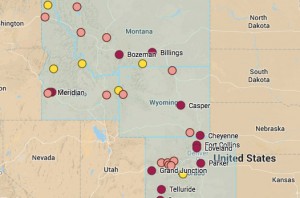Rocky Mountain real estate trends away from strip malls, toward downtown re-development

INTERACTIVE MAP: The RESTORE commercial real estate study looked at 32 towns and cities throughout a 4-state area. View the interactive map here.
An in-depth study recently released by Community Builders, a project of the Sonoran Institute, shows how commercial real estate in the American West is trending away from single-use malls on the outskirts of town and toward smaller shops and a complete shopping “experience” in town centers.
The study, called RESTORE: Commercial and Mixed-use Development Trends in the Rocky Mountain West is a follow-up to Community Builders’ 2013 study, RESET: Assessing Future Housing Markets in the Rocky Mountain West, which found that 90 percent of survey respondents would prefer living within an easy walk to other places in the community.
“When it comes to commercial real estate in the American West today, the hot spot to be is on the corner of downtown Main Street, right in the heart of town, preferably in an area with a mix of housing, office and retail,” said Clark Anderson of Community Builders, which has offices in Glenwood Springs and Bozeman, Montana. “The strip mall isn’t dead, but we’re seeing retailers trying to adapt in an era when e-commerce has taken off and when people do go out to shop, they want a richer experience.”

RESTORE provided analysis of commercial markets throughout the west, with a special focus on 32 towns and cities in Colorado, Wyoming, Montana and Idaho. Pictured above, the lofts at 1201 in downtown Durango, Colorado, are home to 22 lofts and five commercial units. The project was one of 11 case studies reviewed as part of the analysis.
The effort to create a shopping “experience” stems from well-established trends taking place on the national level. These trends include the rise of online shopping, changing preferences among Generation Y and Baby Boomers, and the growing desire for pedestrian amenities. Brick-and-mortar retailers are “right-sizing” their stores into smaller-square-footage locations and seeking areas that offer a diverse set of possible activities within walking distance.
RESTORE takes a deeper look at how these trends play out in the unique markets of the Intermountain West. The report examines how these shopping trends take a different shape, and require a different response based on factors such as a town’s size, location, population density and mean income.
Towns and cities studied
Along with 11 case studies, which focused on particular mixed-use development throughout the West, the RESTORE study also focused on these 32 towns and cities in the study area
(Tier A):
Durango, Colo.
Fort Collins, Colo.
Grand Junction, Colo.
Loveland, Colo.
Parker, Colo.
Telluride, Colo.
Boise, Idaho
Meridan, Idaho
Billing, Mont.
Bozeman, Mont.
Casper, Wyo.
and Cheyenne, Wyo.;
(Tier B):
Basalt, Colo.
Carbondale, Colo.
Eagle, Colo.
Glenwood Springs, Colo.
Rifle, Colo.
Coeur d’Alene, Idaho
Idaho Falls, Idaho
Nampa, Idaho
Helena, Mont.
Kalispell, Mont.
Missoula, Mont.
Jackson, Wyo.
Laramie, Wyo.
and Sheridan, Wyo.
(Tier C):
Buena Vista, Colo.
McCall, Idaho
Salmon, Idaho
Sandpoint, Idaho
Teton County, Idaho
and Red Lodge, Mont.
Rather than a one-size-fits all response, RESTORE identifies three types of Western cities: Tier A (large), Tier B (medium), and Tier C (small), and matches these types of cities with recommendations for mixed-use development that are consistent with the realities of life in the American West.
“If you’re a developer or investor in McCall, Idaho, you’re going to react to these trends in a different way that if, say, you were in Fort Collins, Colorado,” said Randy Carpenter, director of Community Builders’ Montana office. “This isn’t a one-size-fits-all situation, but at the same time there are sensible things that folks can do to put themselves on strong economic footing in light of these well-established trends.”
The 52-page RESTORE report examines these trends in detail, focusing on 32 towns and cities that are representative of communities throughout the Idaho, Montana, Wyoming and Western Colorado study area.
In addition to matching the appropriate development type to the characteristics of the community, RESTORE recommends a variety of additional tools, like public-private partnerships, joint-ventures, creative use of government incentives for redevelopment and restoration, community engagement and more.
For more information, and to read the full report visit www.communitybuilders.net/RESTORE.

Tom Boyd


You must be logged in to post a comment Login